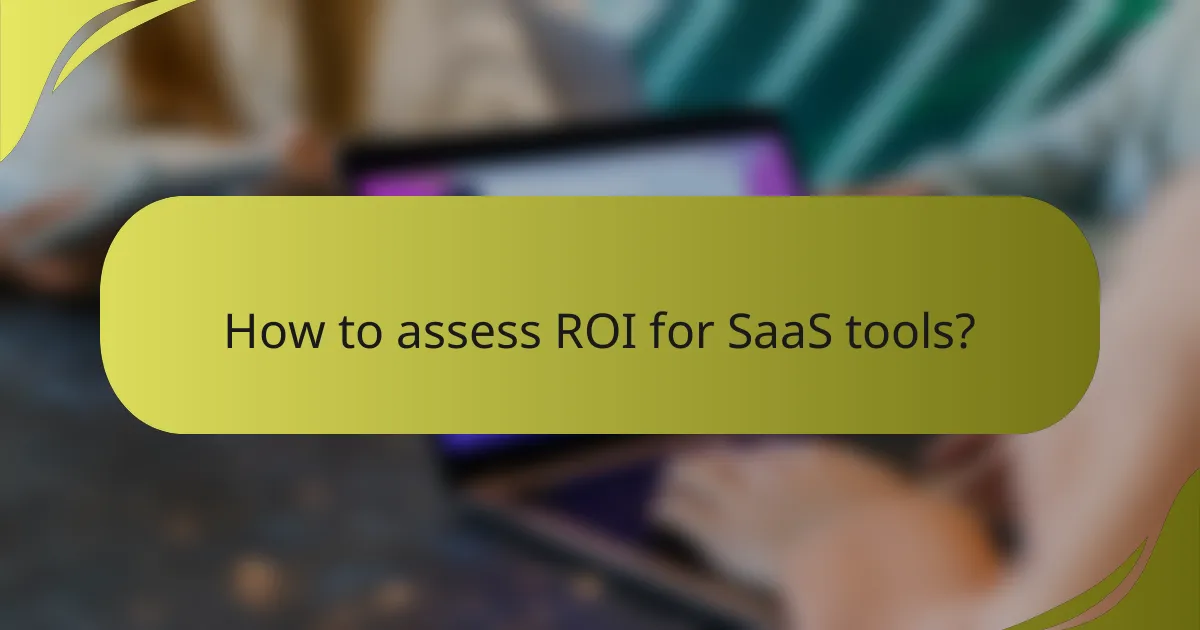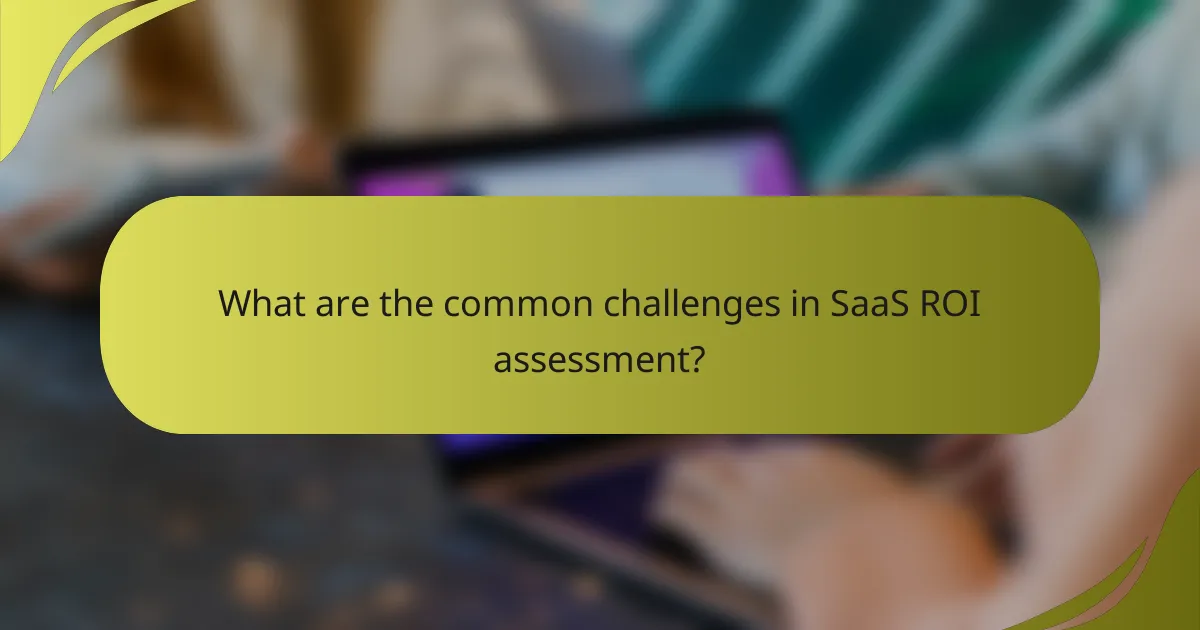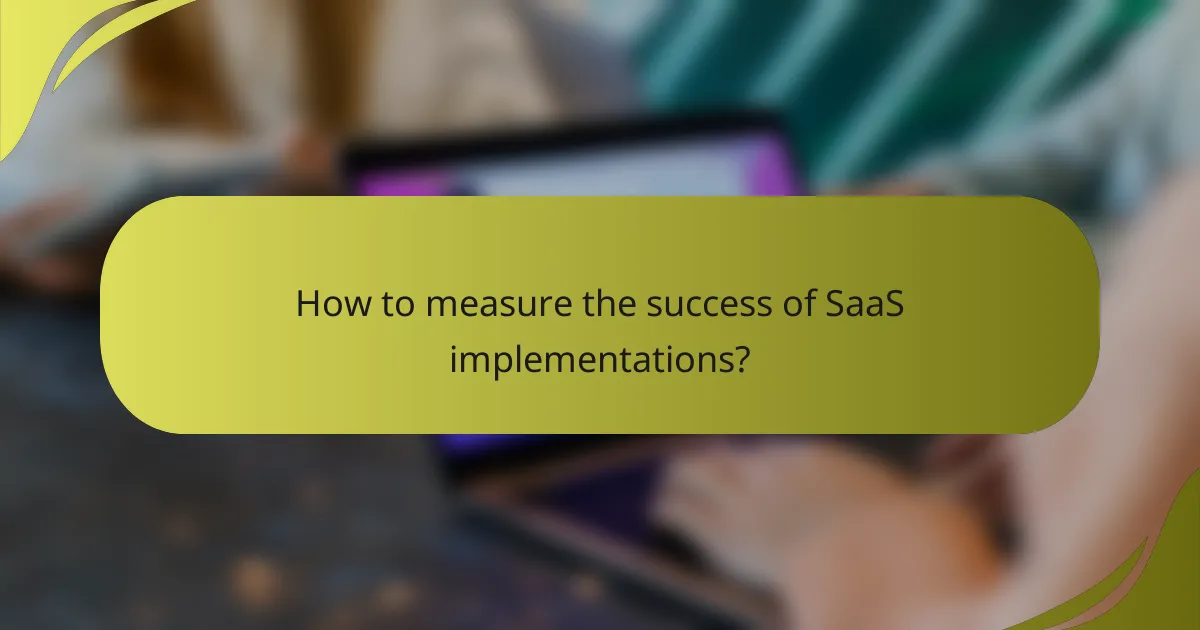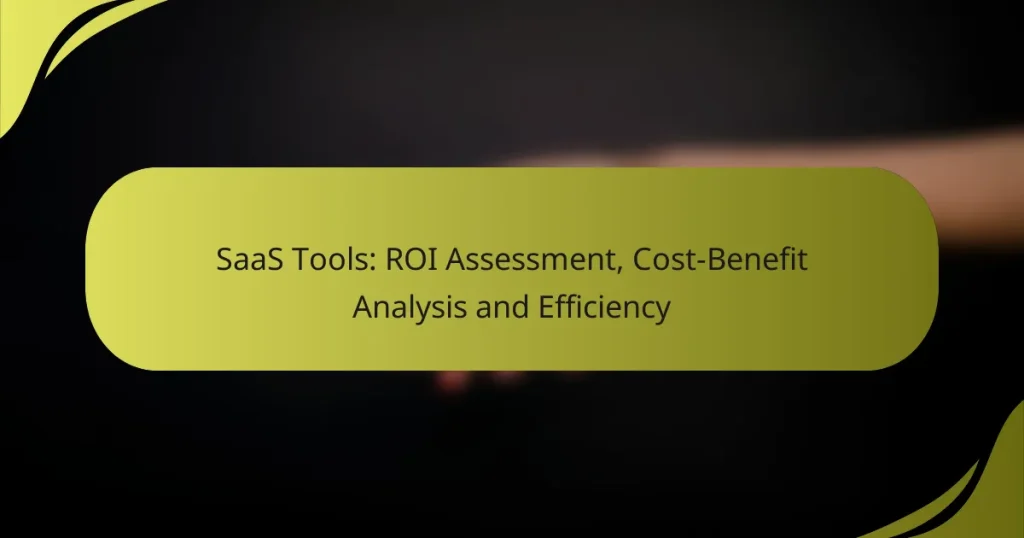Evaluating the return on investment (ROI) for SaaS tools is crucial for businesses to understand the financial benefits relative to their costs. A thorough cost-benefit analysis helps organizations assess the value of adopting these solutions, ensuring that the expected advantages outweigh the associated expenses. By leveraging SaaS features to enhance efficiency and streamline operations, companies can significantly boost productivity and reduce costs.

How to assess ROI for SaaS tools?
Assessing ROI for SaaS tools involves evaluating the financial return generated from the investment compared to its costs. This process helps businesses determine whether a SaaS solution is worth the expense and how it contributes to overall efficiency and productivity.
ROI calculation methods
There are several methods to calculate ROI for SaaS tools, including the simple ROI formula, which is (Net Profit / Cost of Investment) x 100. Another approach is the Total Cost of Ownership (TCO), which considers all costs associated with the software, including subscription fees, implementation, and maintenance.
Additionally, businesses can use payback period analysis, which measures how long it takes for the investment to pay for itself. This method is particularly useful for assessing cash flow impacts and making quick decisions.
Key performance indicators
Key performance indicators (KPIs) for assessing ROI in SaaS tools include customer acquisition cost (CAC), customer lifetime value (CLV), and churn rate. Monitoring these metrics helps businesses understand the effectiveness of their SaaS investments.
Other important KPIs may include productivity improvements, time savings, and user engagement levels. Establishing clear benchmarks for these indicators allows for more accurate ROI assessments over time.
Real-world examples
A company using a project management SaaS tool might find that it reduces project completion time by 20%, leading to increased revenue opportunities. If the tool costs $1,000 annually, the ROI can be calculated based on the additional revenue generated from faster project delivery.
In another case, a business that implements a customer relationship management (CRM) system could see a decrease in customer churn from 15% to 10%. By calculating the increased revenue from retained customers against the CRM’s costs, the company can effectively assess the ROI of the investment.

What is a cost-benefit analysis for SaaS?
A cost-benefit analysis (CBA) for SaaS evaluates the financial implications of adopting a software-as-a-service solution. It involves comparing the expected benefits of using the software against the associated costs to determine its overall value and justify the investment.
Components of cost-benefit analysis
The primary components of a cost-benefit analysis include direct costs, indirect costs, and benefits. Direct costs encompass subscription fees, implementation expenses, and maintenance charges. Indirect costs may involve training, downtime during the transition, and potential productivity losses.
On the benefits side, consider both tangible and intangible gains. Tangible benefits might include increased revenue or cost savings, while intangible benefits could involve improved employee satisfaction or enhanced customer experience. Assigning a monetary value to these benefits is crucial for a comprehensive analysis.
Tools for cost-benefit analysis
Several tools can assist in conducting a cost-benefit analysis for SaaS. Spreadsheet software like Microsoft Excel or Google Sheets is commonly used for creating detailed financial models and projections. These tools allow for easy manipulation of data and scenario analysis.
Additionally, specialized software solutions exist that streamline the CBA process. Tools such as CBA calculators or financial modeling applications can automate calculations and provide visual representations of data, making it easier to communicate findings to stakeholders.

How to improve efficiency with SaaS tools?
Improving efficiency with SaaS tools involves leveraging their features to streamline operations and reduce costs. By automating processes and enhancing collaboration, businesses can achieve significant productivity gains.
Best practices for efficiency
To maximize efficiency with SaaS tools, start by clearly defining your business objectives and selecting tools that align with those goals. Regularly review usage metrics to identify underutilized features and adjust your strategy accordingly.
Training staff on the effective use of these tools is crucial. Implementing a structured onboarding process can help employees quickly adapt and utilize the software to its full potential, reducing time spent on manual tasks.
Integration with existing systems
Integrating SaaS tools with your current systems is essential for seamless operations. Ensure that the chosen tools can connect with existing software, such as CRM or ERP systems, to avoid data silos and enhance workflow efficiency.
Consider using APIs or middleware solutions to facilitate integration. This approach allows for real-time data sharing and can significantly reduce the time spent on data entry and reconciliation, leading to improved operational efficiency.

What are the common challenges in SaaS ROI assessment?
Common challenges in SaaS ROI assessment include data accuracy issues and resistance to change. These obstacles can hinder effective evaluation and decision-making regarding the adoption and continued use of SaaS tools.
Data accuracy issues
Data accuracy is crucial for a reliable ROI assessment. Inaccurate or incomplete data can lead to misguided conclusions about the effectiveness and value of SaaS solutions. Organizations should ensure that the data collected is consistent, up-to-date, and relevant to the specific metrics being analyzed.
To enhance data accuracy, consider implementing automated data collection processes and regular audits. This may involve using integrated systems that minimize manual entry errors and ensure that all relevant data points are captured. For instance, tracking user engagement and performance metrics can provide clearer insights into SaaS effectiveness.
Resistance to change
Resistance to change is a significant barrier when assessing SaaS ROI. Employees may be hesitant to adopt new tools due to fear of disruption or lack of familiarity. This reluctance can skew usage data and affect overall ROI calculations.
To mitigate resistance, involve team members early in the decision-making process and provide comprehensive training on the new tools. Highlighting the benefits of SaaS solutions, such as increased efficiency or cost savings, can also help ease concerns. Regular feedback sessions can further foster a culture of openness and adaptability.

What criteria should be used for selecting SaaS tools?
When selecting SaaS tools, consider factors such as feature set, vendor reputation, pricing, and integration capabilities. These criteria help ensure that the chosen tools effectively meet your business needs and provide a good return on investment.
Feature comparison
Feature comparison involves evaluating the specific functionalities of each SaaS tool against your requirements. Start by listing essential features that your organization needs, such as user management, reporting capabilities, or customer support options. Prioritize tools that offer a comprehensive feature set that aligns with your operational goals.
Additionally, consider the ease of use and customization options. A tool with a user-friendly interface can enhance adoption rates among employees, while customization allows you to tailor the software to your unique workflows. Create a comparison table to visualize how different tools stack up against each other on key features.
Vendor reputation
Vendor reputation is crucial when selecting SaaS tools, as it reflects the reliability and quality of the service. Research customer reviews, case studies, and industry rankings to gauge the vendor’s standing in the market. Look for feedback on customer support, uptime reliability, and overall user satisfaction.
Engage with current users through forums or social media to gain insights into their experiences. A vendor with a strong reputation is more likely to provide consistent updates, security patches, and responsive customer service, which are vital for maintaining operational efficiency.

How to measure the success of SaaS implementations?
Measuring the success of SaaS implementations involves assessing performance metrics, user satisfaction, and overall return on investment (ROI). Key indicators include cost savings, productivity improvements, and user engagement levels.
Post-implementation reviews
Post-implementation reviews are critical for evaluating the effectiveness of a SaaS solution. These reviews typically occur a few months after deployment and focus on performance metrics, user adoption rates, and alignment with business goals.
During these reviews, gather quantitative data such as usage statistics and qualitative insights from team members. This can help identify areas for improvement and ensure the software meets organizational needs.
User feedback mechanisms
User feedback mechanisms are essential for understanding the user experience and satisfaction with the SaaS tool. Implement surveys, interviews, or feedback forms to gather insights directly from users about their experiences and challenges.
Consider using a structured approach, such as Net Promoter Score (NPS) or Customer Satisfaction Score (CSAT), to quantify user sentiment. Regularly reviewing this feedback can help inform future enhancements and ensure the tool remains effective and user-friendly.

What are the emerging trends in SaaS ROI assessment?
Emerging trends in SaaS ROI assessment focus on leveraging advanced technologies and methodologies to enhance decision-making. Key developments include AI-driven analytics, predictive modeling techniques, and the integration of financial metrics to provide a clearer picture of value and efficiency.
AI-driven analytics
AI-driven analytics are transforming SaaS ROI assessments by enabling organizations to analyze vast amounts of data quickly and accurately. These tools can identify patterns and trends that may not be immediately visible, allowing businesses to make informed decisions based on real-time insights.
For example, AI can help predict customer churn by analyzing usage patterns, which can inform retention strategies. Companies can expect to see improved ROI through targeted interventions that reduce churn rates and enhance customer satisfaction.
Predictive modeling techniques
Predictive modeling techniques utilize historical data to forecast future outcomes, making them essential for assessing SaaS ROI. By employing statistical algorithms and machine learning, organizations can estimate the potential financial impact of different scenarios, helping to guide investment decisions.
Common applications include forecasting revenue growth based on user acquisition trends or estimating cost savings from operational efficiencies. Businesses should consider using these models to simulate various strategies and their potential ROI before committing resources.
Integration of financial metrics
Integrating financial metrics into SaaS ROI assessments allows for a comprehensive evaluation of performance. Key metrics such as Customer Acquisition Cost (CAC), Lifetime Value (LTV), and Monthly Recurring Revenue (MRR) provide critical insights into the financial health of a SaaS business.
For effective assessments, organizations should regularly review these metrics and adjust their strategies accordingly. A balanced approach that considers both operational efficiency and financial performance will lead to more accurate ROI evaluations and better long-term outcomes.


